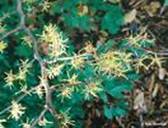| Kingdom | Plantae |
| Division | Magnoliophyta |
| Class | Magnoliopida |
| Order | Saxifragales |
| Family | Hamamelidaceae |
| Genus | Hamamelis |
| Species | H.virginiana |
| Binomial name | Hamamelis virginiana |
Other Common Names:
The other common names for the shrub hazelnut are Pistachio, Snapping Hazelnut, Spotted Alder, Striped Alder, Tobacco Wood, Winterbloom and Witch Hazel.
History
Hamamelis virginiana, also known as Hazel Nut is part of the Hamamelidaceae plant family. The generic name, Hamamelis, comes from a name that Hippocrates applied to the medlar (a small hawthorn-like fruit). The name combines two Greek word roots meaning fruit (apple) and "together," referring to the plant's habit of producing flowers at the same time the previous year's fruits mature and disperse seed.

Description
It is a shrub or small tree up to 15 feet tall. The bark of witch hazel, which grows up to a height of 15 feet, is normally gray and brownish in colour. It has broadly oval leaves with large rounded teeth. It has very odd flowers, as seen in the picture below. The four petals are long, strap-shaped and wavy. They are bright yellow, sometimes tinged with red. Behind them are four tiny, triangular, dull-yellow sepals. Since the flowers often grow in clusters of two or three, they give the appearance more of bright yellow long-legged insects than of flowers.


Range
Witch Hazel is found in Canada and Northern American States. Witch Hazel grows throughout the Eastern United States and Canada, from Nova Scotia to Georgia and Nebraska. Witch hazel is from Nova Scotia and Quebec west to northern Michigan and southeast Minnesota, south to Florida and Texas.
Habitat
Common witch hazel flourishes on shaded north-facing slopes, along fence rows, country roads, and the stony banks of brooks. Preferring light shade, eastern witch hazel can grow to a height of 10 to 12 feet.
Cultivation
Witch hazel prefers evenly moist, acidic soil but can adapt to a range of soil conditions. Grow in full sun to partial shade. In the wild it often grows as an under story shrub, at the edge of a bog or field. Reasonably care-free, witch hazel will grow into an attractive form with minimal pruning. Water regularly for the first year and during periods of extended drought after. It is rarely bothered by pests or diseases. Witch hazel can be propagated either from hardwood cuttings or from the seeds of the tree. In both cases, the plantation is done in autumn and the leaves of the tree, which are of maximum medicinal value, are collected during the summer and dried before storing. On the other hand, the barks of the shrub are collected in autumn and dried immediately in the shade before storing.
Flowering Season
Witch hazel blossoms from September to November and the flowers have petals that look like twined yellowish straps and they blossom completely after the leaves have shed from the branches.
Pests and Diseases
Hazel weevil is the worst enemy of hazelnuts in Europe and Minor Asia attacking the tender nut and producing a typical whole, destroying afterwards the kernel and causing severe damages. The bud mite, Phytoptus avellanae Nal, is present in all hazelnut producing countries. In Oregon (USA) the filbertworm (Melissopus latiferreanus) represents the main pest. Other pests are caused by Zeuzera pyrina, Eulecanium coryli, Archips rosanus and Nezara viridula.'Bacterial blight', caused by Xanthomonas campestris pv. Corylina is a serious disease in nurseries and young orchards in Oregon, Eastern Europe, France and Italy. In layer beds bacterial blight affects stems and lateral herbaceous shoots, symptoms include necrosis and drying-out; this disease can girdle and fill young trees.
Parts Used

The most commonly used parts of the plant are dried and fresh leaves and dried bark for its medicinal and commercial applications.
Medicinal Applications

• The distilled twigs of witch hazel are an important ingredient in eye drops, ointments, and skin creams and tonics.
• It is used in treating colitis, diarrhoea, dysentery, dysmenorrhoea, eye inflammations, haematuria, kidney pains, neuralgia, nosebleeds and excessive menstruation.
• Topically for minor skin lesions, bruises and sprains, local inflammation of the skin and mucous membranes, haemorrhoids and varicose veins.
• Hazelnut is also used as a tonic.
• The tincture of witch hazel has multifarious medicinal uses and is beneficial when used externally to heal inflammation of the skin, sunburn, insect bites and stings, bruises, scratches, poison ivy/oak, diaper rash, eczema and bedsores.
• The tea is also useful for healing vaginitis when used as a vaginal douche for cleansing the vagina by flushing fluids.
• A witch hazel lotion can also be applied as a skin toner to tauten up tissues as well as lessen wrecked blood vessels.
Commercial Applications


• It is a common ingredient in soaps, face washes and shampoos. One of the first commercially available skin care products in the United States was Pond's Extract, made from witch hazel.
• It is used as massage oil for sore muscles and as a natural deodorant.
• Americans used to make their bows out of the pliable wood.
• It is also used as a poultice for painful swellings and tumours.

People have used witch hazels for centuries in medicines as well as for divining or dowsing sticks to search for water sources. Named for the occult powers attributed to these plants, the hazel-like branches were once used as divining rods for water and gold. Twigs of hazelnut (forked) were used for water divining and when carried was thought to help cool passions. It is also believed to help heal a broken heart when carried.